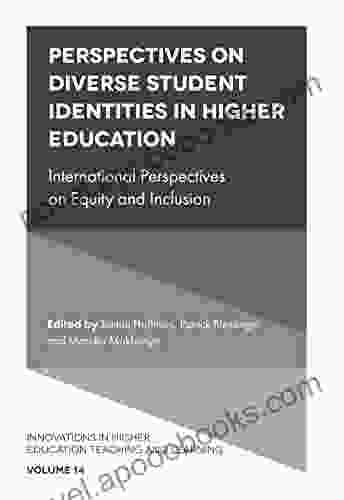Unlocking a World of Equity and Inclusion: A Comprehensive Guide for Higher Education


Higher education should be accessible and inclusive for all students.
5 out of 5
| Language | : | English |
| File size | : | 4321 KB |
| Text-to-Speech | : | Enabled |
| Screen Reader | : | Supported |
| Enhanced typesetting | : | Enabled |
| Word Wise | : | Enabled |
| Print length | : | 197 pages |
In today's globalized world, higher education has become increasingly important for individuals and societies alike. It is widely recognized that higher education can lead to better job opportunities, higher incomes, and improved social mobility. However, despite the many benefits of higher education, there are still significant disparities in access and outcomes for students from different backgrounds.
Equity and inclusion are two essential components of a high-quality higher education system. Equity means that all students have an equal opportunity to succeed, regardless of their background or circumstances. Inclusion means that all students feel welcome and respected in the classroom and on campus.
Creating a more equitable and inclusive higher education system is a complex challenge, but it is one that is essential to address. In this book, we provide a comprehensive overview of the latest research and best practices on equity and inclusion in higher education. We cover a wide range of topics, including:
- The history of equity and inclusion in higher education
- The current state of equity and inclusion in higher education
- The challenges to creating a more equitable and inclusive higher education system
- The best practices for creating a more equitable and inclusive higher education system
We hope that this book will be a valuable resource for researchers, policymakers, and practitioners who are working to create a more equitable and inclusive higher education system.
Chapter 1: The History of Equity and Inclusion in Higher Education
The history of equity and inclusion in higher education is a long and complex one. In the early days of higher education, only a small number of students had the opportunity to attend college. These students were typically white, male, and from wealthy families.
Over time, the demographics of higher education began to change. In the 20th century, more and more women and students from minority backgrounds began to attend college. However, these students still faced significant barriers to success.
In the 1960s and 1970s, the civil rights movement and the women's movement led to a number of laws and policies that were designed to promote equity and inclusion in higher education. These laws and policies included the Civil Rights Act of 1964, the Equal Educational Opportunities Act of 1974, and the Title IX Education Amendments of 1972.
These laws and policies have had a significant impact on equity and inclusion in higher education. However, there is still more work to be done. Today, there are still significant disparities in access and outcomes for students from different backgrounds.
Chapter 2: The Current State of Equity and Inclusion in Higher Education
The current state of equity and inclusion in higher education is complex. There have been significant improvements in recent decades, but there are still significant disparities in access and outcomes for students from different backgrounds.
For example, the graduation rate for white students is still significantly higher than the graduation rate for black students and Hispanic students. Additionally, students from low-income families are less likely to attend college than students from high-income families.
These disparities are due to a number of factors, including:
- Differences in access to high-quality early childhood education
- Differences in access to college preparatory courses in high school
- Differences in financial resources
- Differences in cultural and social capital
These disparities are a serious problem. They limit the opportunities of students from disadvantaged backgrounds and they prevent our higher education system from reaching its full potential.
Chapter 3: The Challenges to Creating a More Equitable and Inclusive Higher Education System
Creating a more equitable and inclusive higher education system is a complex challenge. There are a number of barriers that need to be overcome, including:
- Lack of funding
- Institutional racism
- Stereotypes and biases
- Lack of access to support services
Lack of funding is a major barrier to equity and inclusion in higher education. Many colleges and universities do not have the resources to provide the support services that students from disadvantaged backgrounds need to succeed.
Institutional racism is another major barrier to equity and inclusion in higher education. Institutional racism is the systemic and ingrained racism that exists in institutions and organizations.
Stereotypes and biases are also barriers to equity and inclusion in higher education. Stereotypes and biases can lead to discrimination against students from disadvantaged backgrounds.
Lack of access to support services is another barrier to equity and inclusion in higher education. Students from disadvantaged backgrounds often need access to support services such as tutoring, counseling, and financial aid.
Chapter 4: The Best Practices for Creating a More Equitable and Inclusive Higher Education System
Despite the challenges, there are a number of things that colleges and universities can do to create a more equitable and inclusive higher education system. Some of the best practices include:
- Increase funding for equity and inclusion initiatives
- Implement anti-racist policies and practices
- Provide cultural competency training for faculty and staff
- Increase access to support services for students from disadvantaged backgrounds
- Create a more inclusive campus climate
Increasing funding for equity and inclusion initiatives is essential to creating a more equitable and inclusive higher education system. Colleges and universities need to invest in programs and services that support students from disadvantaged backgrounds.
Implementing anti-racist policies and practices is also essential to creating a more equitable and inclusive higher education system. Colleges and universities need to adopt policies and practices that
5 out of 5
| Language | : | English |
| File size | : | 4321 KB |
| Text-to-Speech | : | Enabled |
| Screen Reader | : | Supported |
| Enhanced typesetting | : | Enabled |
| Word Wise | : | Enabled |
| Print length | : | 197 pages |
Do you want to contribute by writing guest posts on this blog?
Please contact us and send us a resume of previous articles that you have written.
 Book
Book Novel
Novel Page
Page Chapter
Chapter Text
Text Story
Story Genre
Genre Reader
Reader Library
Library Paperback
Paperback E-book
E-book Magazine
Magazine Newspaper
Newspaper Paragraph
Paragraph Sentence
Sentence Bookmark
Bookmark Shelf
Shelf Glossary
Glossary Bibliography
Bibliography Foreword
Foreword Preface
Preface Synopsis
Synopsis Annotation
Annotation Footnote
Footnote Manuscript
Manuscript Scroll
Scroll Codex
Codex Tome
Tome Bestseller
Bestseller Classics
Classics Library card
Library card Narrative
Narrative Biography
Biography Autobiography
Autobiography Memoir
Memoir Reference
Reference Encyclopedia
Encyclopedia Philip C Kolin
Philip C Kolin Peter Baker
Peter Baker United Nations
United Nations Phillip Manning
Phillip Manning Philip Short
Philip Short Pat Porter
Pat Porter William W Johnstone
William W Johnstone Margaux Deroux
Margaux Deroux Rasha Abbas
Rasha Abbas Rachel Denbow
Rachel Denbow Walter Trobisch
Walter Trobisch Rachel Hanna
Rachel Hanna Philip Fracassi
Philip Fracassi Richardson Chaperon
Richardson Chaperon Mary Freeman
Mary Freeman Hugo Ortega
Hugo Ortega The Beatles
The Beatles Tish Oney
Tish Oney Richard Dotts
Richard Dotts Paul T Hill
Paul T Hill
Light bulbAdvertise smarter! Our strategic ad space ensures maximum exposure. Reserve your spot today!

 Hamilton BellCry Voice In The Wilderness: A Spine-Tingling Saga of Survival and Redemption
Hamilton BellCry Voice In The Wilderness: A Spine-Tingling Saga of Survival and Redemption
 Raymond ParkerEmbark on an Emotional Adventure with "All About Feelings: An Alphabet for...
Raymond ParkerEmbark on an Emotional Adventure with "All About Feelings: An Alphabet for...
 Leon FosterAn Airline Pilot Story: A Thrilling Tale of Aviation, Adventure, and Personal...
Leon FosterAn Airline Pilot Story: A Thrilling Tale of Aviation, Adventure, and Personal... Henry GreenFollow ·19.9k
Henry GreenFollow ·19.9k Jared NelsonFollow ·19.1k
Jared NelsonFollow ·19.1k Ivan TurnerFollow ·17.7k
Ivan TurnerFollow ·17.7k Bryan GrayFollow ·11.6k
Bryan GrayFollow ·11.6k Gerald ParkerFollow ·7.8k
Gerald ParkerFollow ·7.8k Richard WrightFollow ·6.6k
Richard WrightFollow ·6.6k Galen PowellFollow ·18.1k
Galen PowellFollow ·18.1k Dan HendersonFollow ·17.1k
Dan HendersonFollow ·17.1k

 Shaun Nelson
Shaun NelsonUnlocking the Intricate Nexus: The Globalization and the...
In an era marked by...

 Robin Powell
Robin PowellLast Summer at the Golden Hotel: A Captivating Journey of...
Synopsis: A Transformative Summer at...

 Gabriel Mistral
Gabriel MistralContracts And Conmen In Europe Scramble For Africa
The late 19th and early...

 Glenn Hayes
Glenn HayesThe Story of the United States' Longest Wildcat Strike: A...
Prologue: The...

 Evan Hayes
Evan HayesBritain Empire Resistance Repression And Revolt:...
: The Tapestry of...

 Eddie Bell
Eddie BellGreen's Operative Hand Surgery: The Ultimate Guide for...
Green's Operative Hand Surgery is the...
5 out of 5
| Language | : | English |
| File size | : | 4321 KB |
| Text-to-Speech | : | Enabled |
| Screen Reader | : | Supported |
| Enhanced typesetting | : | Enabled |
| Word Wise | : | Enabled |
| Print length | : | 197 pages |






